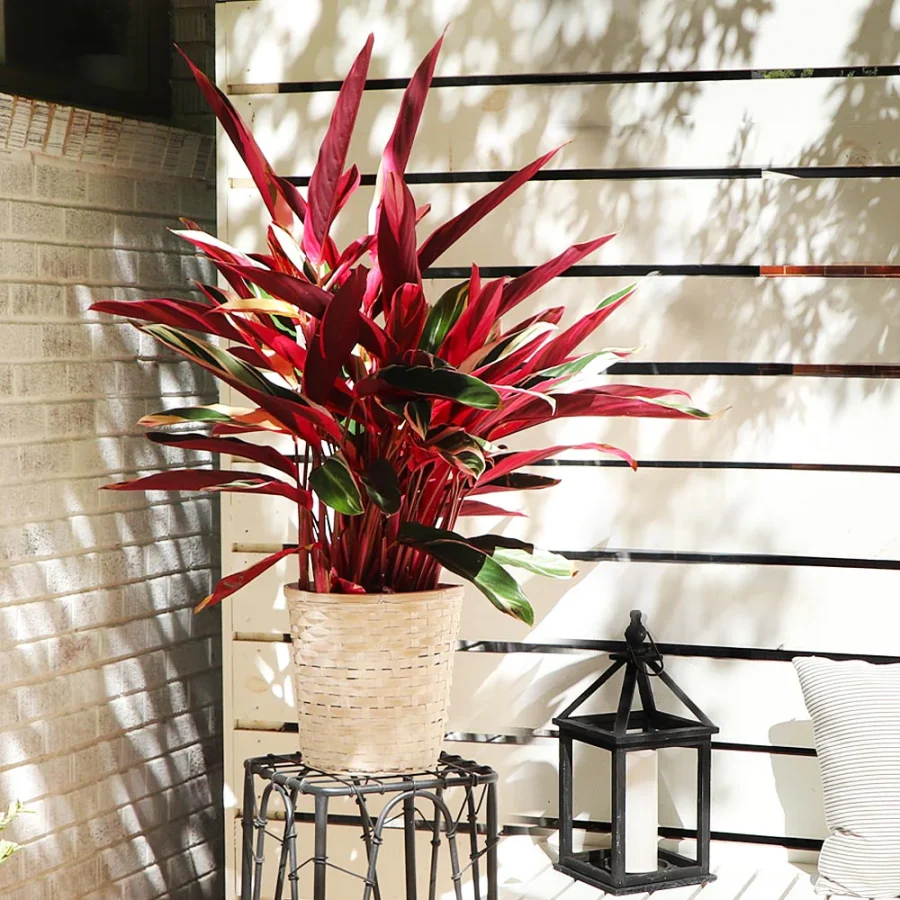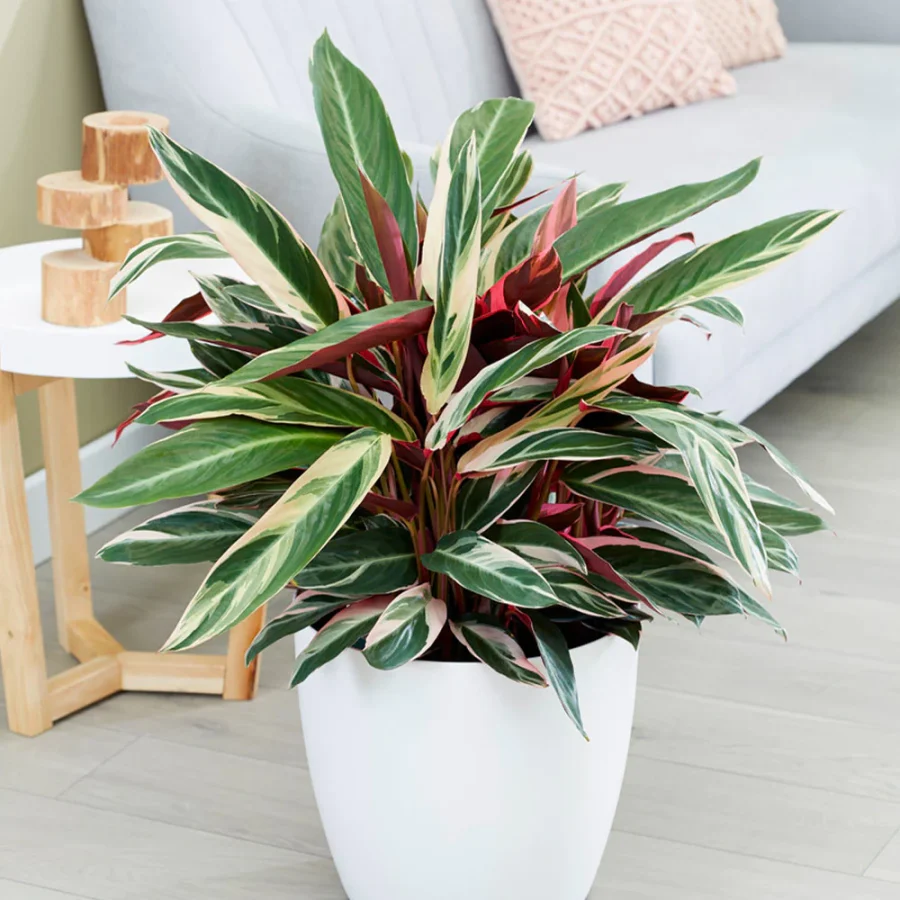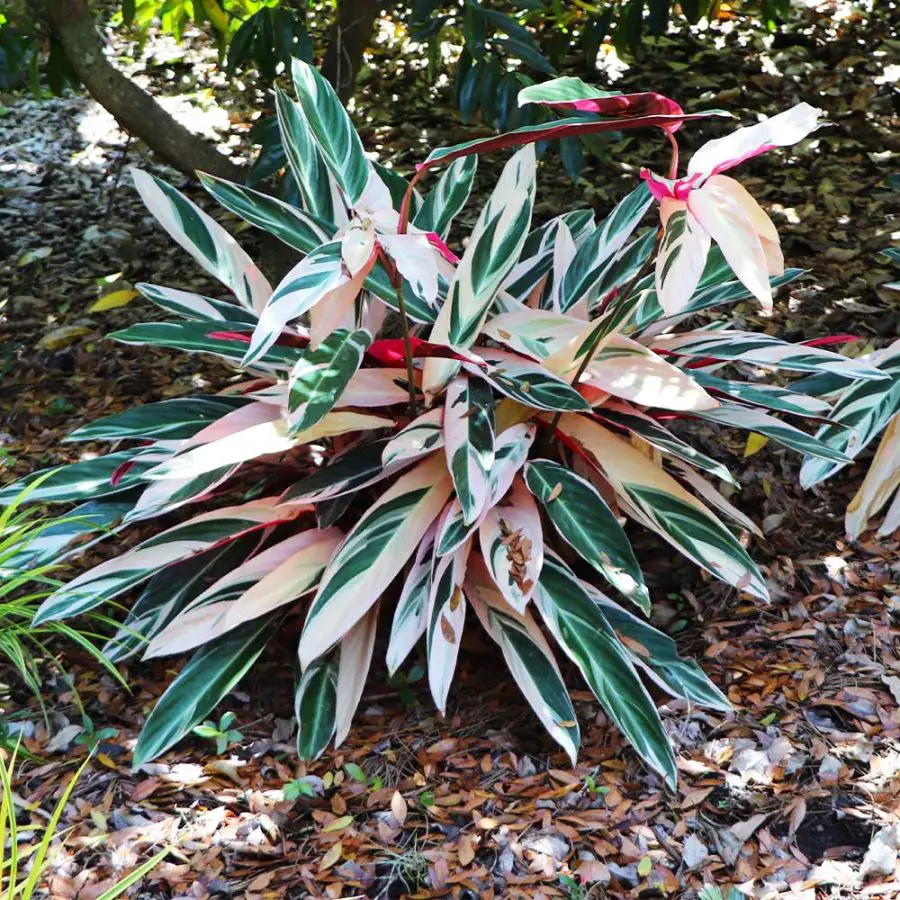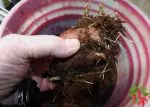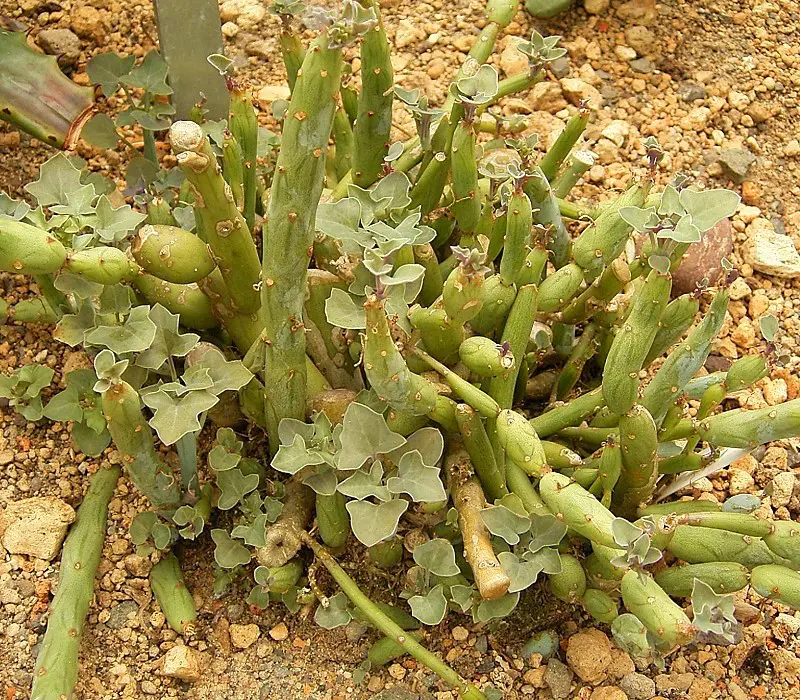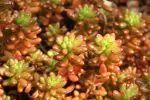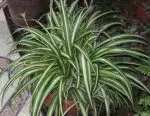This post contains affiliate links. If you buy something from one of our links we may earn a commission. Thanks
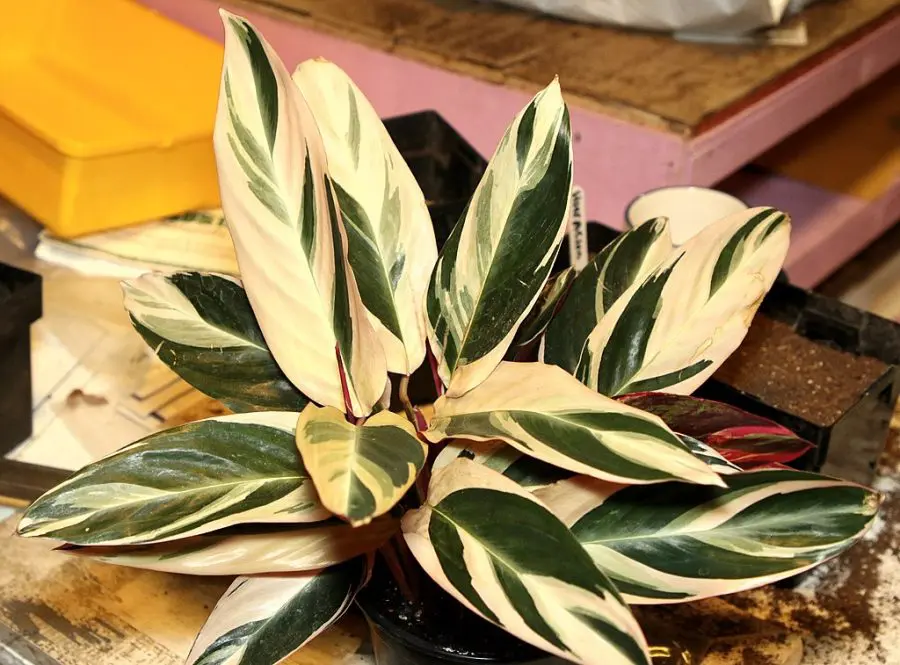
Discover Stromanthe Triostar Care tips and tricks in our easy-to-follow guide, covering lighting, watering, and more to help your Tricolor Ginger Plant thrive!
Stromanthe Triostar or Tricolor Ginger Plant care is fairly straightforward but requires attention to detail. Place the plant in indirect light, maintain high humidity, and keep the soil evenly moist. Opt for a well-draining soil mix and keep the temperature between 65-80°F for optimal growth.
Welcome to the colorful world of Stromanthe Triostar Care! With its striking variegated leaves and captivating purple undersides, the Tricolor Ginger Plant is sure to add a touch of tropical flair to your indoor garden.
If you’re ready to explore the secrets to keeping this gorgeous plant happy and healthy, you’ve come to the right place.
Let’s dive into our comprehensive guide and turn your space into a lush, vibrant haven for your Stromanthe Triostar.
Introduction: What is Stromanthe Triostar?
Ready to embark on an exciting journey into the enchanting realm of Stromanthe Triostar?
This captivating plant, also known as the Tricolor Ginger Plant, is prized for its stunning variegated leaves and rich purple undersides.
In this post, we’ll explore everything you need to know to nurture your Stromanthe Triostar, from light requirements and watering to propagation and potential problems.
So let’s get started, and prepare to transform your indoor space into a breathtaking tropical sanctuary with the help of your vibrant new addition!
The Science Behind the Beauty
Did you know that the Stromanthe Triostar’s scientific name is Stromanthe sanguinea? This beautiful plant belongs to the Marantaceae family, which is native to the Brazilian rainforest.
Knowing the scientific name can help you find more specific information on care and cultivation when needed.
A Vibrant Nickname: Tricolor Ginger Plant
Stromanthe sanguinea is commonly known as the Tricolor Ginger Plant due to its distinctively colorful foliage.
The combination of green, white, and pink on the top of the leaves, along with the deep purple undersides, truly sets this plant apart from others in your indoor garden.
This nickname highlights its vibrant personality and the tropical ambiance it brings to your space.
What Makes Tricolor Ginger Plants Special?
The Tricolor Ginger Plant presents a stunning twist on traditional variegated foliage, featuring striking reds and pinks alongside the classic white found in other varieties.
The best part? This versatile plant flourishes both outdoors and indoors in containers, making it a perfect addition for plant enthusiasts all over the country!
With its tropical allure, the Tricolor Ginger Plant showcases exotic, oblong green leaves adorned with vivid red hues. Its adaptability as a container plant allows you to place it anywhere, from cozy tabletops to busy office desks.
Plus, it’s low-maintenance – just provide some sun and water, and watch it thrive.
You Can Get Your Stromanthe Triostar Tricolor Ginger Here
Stromanthe Triostar Indoor Benefits
Are you curious about the perks of bringing a Stromanthe Triostar into your home?
Aside from its undeniable beauty, this Tricolor Ginger Plant offers a variety of indoor benefits that can improve both your living space and your well-being.
In this section, we’ll delve into the many advantages of having a Stromanthe Triostar as part of your indoor plant collection.
So, let’s uncover the magic this stunning plant has in store for you and your home!
Breathe Easy: Air Purifying Qualities
One of the fantastic benefits of having a Stromanthe Triostar in your home is its air-purifying abilities.
This lovely plant helps remove indoor air pollutants, such as formaldehyde and benzene, contributing to a cleaner and healthier living environment.
So, while your Tricolor Ginger Plant adds beauty to your space, it’s also working hard to improve the air you breathe.
A Visual Treat: Aesthetic Appeal
The Stromanthe Triostar’s stunning variegated leaves with rich purple undersides bring a unique aesthetic appeal to any indoor space.
This eye-catching plant adds a pop of color and a touch of tropical charm, making it an excellent addition to your indoor garden.
Whether you place it on a windowsill, a side table, or the floor, the Tricolor Ginger Plant is sure to enhance your home’s visual ambiance.
A Calming Companion: Stress Reduction
Plants have long been known to provide a sense of calm and well-being, and the Stromanthe Triostar is no exception.
Caring for this beautiful plant can be a soothing and therapeutic activity that helps reduce stress and promote relaxation.
Plus, its vibrant presence can evoke feelings of being in a tranquil, tropical paradise, which can do wonders for your mood and overall well-being.
Stromanthe Triostar Size
Curious about how big your Stromanthe Triostar might grow? In this section, we’ll talk about the typical size and growth rate of this enchanting Tricolor Ginger Plant.
Understanding its growth habits is essential in providing the right care and creating the perfect environment for it to thrive.
So, let’s explore what to expect as your Stromanthe Triostar flourishes in your indoor garden!
Reaching for the Sky: Typical Height
When it comes to the Stromanthe Triostar’s size, you can expect this Tricolor Ginger Plant to reach a height of 4-6 feet (1.2-1.8 meters) under ideal growing conditions.
This makes it a stunning focal point in your indoor garden, whether you choose to showcase it on a plant stand or let it grow tall in a corner of your room.
Patience Pays Off: Growth Rate
The Stromanthe Triostar’s growth rate can vary depending on factors like lighting, temperature, and overall care.
Generally, it’s considered a moderate grower, with the plant reaching its full height in about a year after emerging from its rhizome.
With consistent care and attention, you’ll be able to watch your Tricolor Ginger Plant steadily grow and transform your space into a lush, tropical haven.
Stromanthe Triostar Light Requirements
Wondering how much light your Stromanthe Triostar needs to flourish?
In this section, we’ll shine a light on the ideal conditions for your Tricolor Ginger Plant to thrive.
Providing the right amount of light is essential for maintaining its stunning variegation and ensuring healthy growth.
So, let’s dive into the world of Stromanthe Triostar light requirements and help your plant bask in the perfect glow!
Finding the Sweet Spot: Ideal Light Levels
To keep your Stromanthe Triostar happy, it’s essential to provide it with the right amount of light.
This Tricolor Ginger Plant prefers bright, indirect light for optimal growth.
Direct sunlight can scorch its delicate leaves, while too little light can cause the variegation to fade.
Placing your plant near a north or east-facing window, or using sheer curtains to diffuse the light from a south or west-facing window, can help create the perfect lighting conditions.
A Delicate Balance: Effect of Shade on Variegation
It’s crucial to understand how shade can impact your Stromanthe Triostar’s stunning variegation.
If the plant receives too much shade, the distinctive tricolor pattern on its leaves may be lost, and the foliage could become solid green.
On the other hand, too much direct sunlight can cause leaf burn.
Striking the right balance between light and shade is key to maintaining the vibrant, multi-colored appearance that makes this plant so unique and captivating.
Stromanthe Triostar Watering
Are you wondering how often to water your Stromanthe Triostar?
In this section, we’ll quench your thirst for knowledge about the proper watering techniques for your Tricolor Ginger Plant.
Providing the right amount of water is crucial to keeping your plant healthy and vibrant.
So, let’s dive into the world of Stromanthe Triostar watering and ensure your plant stays hydrated and happy!
Going with the Flow: Frequency
The Stromanthe Triostar prefers consistently moist soil but dislikes sitting in water.
To achieve this balance, you’ll generally need to water your plant once every 7-10 days, depending on the humidity and temperature in your home.
It’s essential to check the top inch of soil before watering; if it’s still moist, wait a few days before giving your Tricolor Ginger Plant another drink.
Staying on the Safe Side: Techniques to Prevent Overwatering
Overwatering can lead to root rot and other issues, so it’s crucial to employ some techniques to prevent it.
First, always use a well-draining soil mix and a pot with drainage holes.
When watering, give your Stromanthe Triostar a thorough soak, allowing excess water to drain away.
You can also try the bottom-watering method by placing your plant in a tray of water and letting it absorb moisture from the bottom up.
Crystal Clear: Problems with Tap Water
Tap water can sometimes contain chemicals like chlorine and fluoride, which may be harmful to your Stromanthe Triostar.
Similar to chlorine, fluoride is commonly added to tap water as a means to combat tooth decay.
However, excessive fluoride concentrations in water can result in leaf problems in houseplants. It can cause yellowing, browning, or curling leaf edges.
If you notice brown tips or other issues that could be related to water quality, consider using filtered or distilled water instead. Rainwater is another good option.
Most localities use chloramine instead of chlorine now. It is much longer lasting and the old trick of letting water stand overnight is no longer effective.
Stromanthe Triostar Soil (Using Coco Coir and Perlite)
Looking for the perfect soil mix for your Stromanthe Triostar?
In this section, we’ll delve into the benefits of using coco coir and perlite to create a well-draining, nutrient-rich environment for your Tricolor Ginger Plant.
Choosing the right soil mix can significantly impact your plant’s health and growth, so let’s explore how to create the ideal foundation for your Stromanthe Triostar to thrive!
The Perfect Blend: Ideal Soil Mix
The Stromanthe Triostar thrives in a well-draining, nutrient-rich soil mix that retains moisture without becoming waterlogged.
A blend of coco coir and perlite creates the perfect environment for your Tricolor Ginger Plant to flourish.
This combination ensures adequate drainage and aeration while providing essential nutrients for healthy growth.
Eco-Friendly Choice: Coco Coir vs. Peat Advantages
Coco coir is an excellent alternative to peat moss for your Stromanthe Triostar soil mix.
It’s an environmentally friendly and sustainable option, as it’s made from the husks of coconuts rather than harvesting peat from non-renewable peat bogs.
Most potting soil mixes contain peat moss.
Coco coir also offers improved aeration and water retention, ensuring your plant’s roots receive the ideal balance of oxygen and moisture.
It also will not compact as peat is prone to do.
Room to Grow: Pot Size and Drainage
Selecting the right pot size and ensuring proper drainage is crucial for your Stromanthe Triostar’s health.
Choose a pot that’s slightly larger than the root ball, providing ample space for growth without being too big.
Make sure the pot has drainage holes to prevent waterlogged soil and root rot.
If you are using potting soil you can add extra perlite to it to improve drainage.
You can also add a layer of pebbles or broken pottery at the bottom of the pot to improve drainage further and keep your Tricolor Ginger Plant happy and healthy.
Stromanthe Triostar Fertilizer
Are you wondering how to keep your Stromanthe Triostar well-fed and thriving?
In this section, we’ll dive into the world of fertilizing your Tricolor Ginger Plant to ensure it receives the essential nutrients it needs for lush, vibrant growth.
Providing the right type and amount of fertilizer can make a significant difference in your plant’s health and appearance.
So, let’s get started on the path to a flourishing, well-nourished Stromanthe Triostar!
Nutrient Boost: Recommended Types
To keep your Stromanthe Triostar nourished, it’s essential to provide it with the right type of fertilizer.
A balanced, water-soluble fertilizer with equal parts nitrogen, phosphorus, and potassium (N-P-K) is ideal for promoting healthy growth and maintaining vibrant foliage.
Look for a fertilizer with a ratio of 10-10-10 or 20-20-20, which should provide the necessary nutrients for your Tricolor Ginger Plant.
Also, it’s a good idea to look for a fertilizer with added trace elements in its formula to avoid mineral deficiencies.
Coco coir like peat moss itself does not provide nutrients it is a growing medium only so be sure to feed your plants.
Consistent Care: Application Frequency
When it comes to fertilizing your Stromanthe Triostar, consistency is key.
During the active growing season (spring and summer), it’s best to apply a diluted fertilizer solution (about half the recommended strength) once every four to six weeks.
This frequency provides the plant with a steady supply of nutrients without overwhelming it.
In the fall and winter, when growth slows down, you can reduce fertilizing to once every two to three months.
By maintaining a consistent fertilization schedule, you’ll help your Tricolor Ginger Plant stay healthy and vibrant year-round.
Stromanthe Triostar Humidity and Temperature
Do you want to recreate the perfect tropical environment for your Stromanthe Triostar?
In this section, we’ll discuss the importance of maintaining the ideal humidity and temperature levels to keep your Tricolor Ginger Plant happy and healthy.
By replicating the conditions of its native rainforest habitat, you’ll encourage lush, vibrant growth and ensure your plant thrives in your home.
So, let’s dive into the world of Stromanthe Triostar humidity and temperature to help your plant feel right at home!
Tropical Comfort: Ideal Humidity Levels
As a native of the Brazilian rainforest, the Stromanthe Triostar loves high humidity levels.
To keep your Tricolor Ginger Plant happy, aim for a humidity level of around 50-60%.
You can achieve this by placing your plant on a tray filled with water and pebbles, using a humidifier, or grouping it with other humidity-loving plants.
Regular misting can also help, but make sure to use distilled or filtered water to avoid leaf spotting.
Cozy and Warm: Temperature Range
The Stromanthe Triostar is a tropical plant and thrives in a warm temperature range. It prefers temperatures between 65-85°F (18-29°C) during the day and no lower than 60°F (15°C) at night.
To keep your plant healthy, avoid placing it near drafts, air conditioners, or heating vents, as sudden temperature changes can cause stress and affect its growth.
By maintaining a consistent temperature range, you’ll help your Tricolor Ginger Plant feel right at home in your indoor garden.
Maintenance and Pruning
Curious about how to keep your Stromanthe Triostar looking its best?
In this section, we’ll share tips and tricks on maintaining and pruning your Tricolor Ginger Plant to ensure it stays healthy and vibrant.
Proper care and attention to your plant’s needs can significantly impact its appearance and overall well-being.
So, let’s get started on mastering the art of Stromanthe Triostar maintenance and pruning for a thriving, beautiful plant!
Timely Trims: When to Prune
Pruning your Stromanthe Triostar is essential for maintaining its health and appearance.
The best time to prune is during the active growing season, which is typically in spring or early summer.
This timing allows your plant to recover quickly and put its energy into new growth.
Keep an eye out for yellowing or damaged leaves, as well as any leggy or overcrowded stems that could benefit from pruning.
Snip and Shape: Techniques for Healthy Growth
To promote healthy growth and maintain your Stromanthe Triostar’s lush appearance, follow these simple pruning techniques:
• First, use clean, sharp scissors or pruning shears to make precise cuts.
• Remove yellowing or damaged leaves by cutting them off at the base of the stem.
• For leggy or overcrowded stems, trim them back to promote bushier growth and allow more light to reach the inner parts of the plant.
• Regularly inspecting and pruning your Tricolor Ginger Plant will help it stay in top shape and maintain its stunning appearance.
Stromanthe Triostar Repotting
 Want to know when and how to repot your Stromanthe Triostar?
Want to know when and how to repot your Stromanthe Triostar?
In this section, we’ll explore the ins and outs of repotting your Tricolor Ginger Plant to give it the space it needs to grow and flourish.
Providing a fresh, nutrient-rich environment is essential for your plant’s health, and proper repotting techniques can make a significant difference.
So, let’s get ready to give your Stromanthe Triostar a brand-new home where it can continue to thrive!
Perfect Timing: When to Repot
Knowing when to repot your Stromanthe Triostar is crucial for its well-being.
Generally, you should consider repotting when the plant becomes root-bound or outgrows its current pot. This typically happens every 2-3 years.
The best time to repot is during the active growing season, usually in spring or early summer, when the plant can recover more quickly and adjust to its new environment.
Home Upgrade: Choosing the Right Pot
When it’s time to repot your Stromanthe Triostar, selecting the right pot is essential.
Choose a container that is about 1-2 inches larger in diameter than the current pot to give the plant enough space to grow without feeling overwhelmed.
Opt for a pot with drainage holes to prevent waterlogged soil and root rot.
Materials like terracotta or ceramic are great choices, as they allow for better moisture and temperature control, ensuring your Tricolor Ginger Plant will be comfortable in its new home.
Plastic pots are cheap and can work well but as your plant grows taller they may not be heavy enough to prevent tipping.
You can always use a plastic pot as the inner pot for a decorative ceramic container once your plant is larger,
Stromanthe Triostar Propagation
Are you ready to multiply the beauty of your Stromanthe Triostar?
In this section, we’ll walk you through the process of propagating your Tricolor Ginger Plant, so you can share its stunning foliage with friends or expand your own indoor jungle.
Propagation can be a fun and rewarding experience, allowing you to grow new plants from your existing one.
So, let’s dive into the world of Stromanthe Triostar propagation and start creating new plant babies!
Propagation Methods (Seeds or Rhizome Division)
When it comes to propagating your Stromanthe Triostar, you have two main methods to choose from: seeds or rhizome division.
While growing from seeds is possible, it can be a slow and less reliable process. On the other hand, rhizome division is faster and offers a higher success rate.
To propagate through rhizome division, you’ll need to separate a section of the plant’s underground rhizome with a healthy growth shoot attached.
Plant Parenting: Tips for Successful Propagation
To increase your chances of successful Stromanthe Triostar propagation, follow these helpful tips.
• For rhizome division, make sure to use a sharp, clean knife to cut the rhizome, and let the cuttings dry for a few hours before planting.
• Plant the divided rhizomes in a well-draining soil mix, such as a combination of coco coir and perlite.
• Keep the new plants in a warm, humid environment with bright, indirect light.
• Water them regularly to maintain consistently moist soil, but be cautious not to overwater.
• With proper care, your new Tricolor Ginger Plants will soon establish roots and begin to grow into stunning specimens.
Stromanthe Triostar Problems
As beautiful as the Stromanthe Triostar is, it can sometimes face challenges that may affect its health and appearance.
In this section, we’ll discuss some common problems you may encounter while caring for your Tricolor Ginger Plant and provide solutions to help you address them.
Being prepared and knowing how to tackle these issues can make a significant difference in your plant’s well-being.
So, let’s arm ourselves with knowledge and keep our Stromanthe Triostar thriving through any obstacles!
Curled Concerns: Stromanthe Triostar Leaves Curling
If you notice your Stromanthe Triostar’s leaves curling, it may be a sign of inadequate watering or humidity.
To address this issue, ensure that you are providing consistent moisture to the plant without overwatering.
You can also increase humidity by using a pebble tray, humidifier, or regular misting with filtered or distilled water.
Tip Troubles: Stromanthe Triostar Brown Tips
Brown tips on your Tricolor Ginger Plant’s leaves can be caused by several factors, such as low humidity, over-fertilization, or exposure to direct sunlight.
To prevent and treat brown tips, maintain a proper humidity level, avoid over-fertilizing, and place your plant in a location with bright, indirect light.
Using tap water can also cause brown tips.
You can trim the brown tips using clean, sharp scissors to improve your plant’s appearance.
Pesky Problems: Pests and Diseases
Stromanthe Triostar plants can be susceptible to common pests like spider mites, aphids, and mealybugs.
Keep an eye out for any signs of infestation and treat promptly with insecticidal soap or neem oil.
Regularly inspect your plant for signs of disease, such as root rot or leaf spot.
To prevent diseases, ensure proper watering practices, provide good air circulation, and keep your plant’s foliage clean and dry.
By staying vigilant and proactive, you can protect your Tricolor Ginger Plant from pests and diseases.
Root Rot
Root rot is a common problem faced by many houseplants, including the Stromanthe Triostar.
It is caused by a combination of overwatering and poor drainage, leading to waterlogged soil and creating an environment where harmful fungi and bacteria can thrive.
These pathogens attack the roots, causing them to rot and ultimately affecting the plant’s ability to take up water and nutrients.
To prevent root rot in your Stromanthe Triostar:
• Ensure proper watering: Water your plant when the top 1-2 inches of soil are dry to the touch. Avoid overwatering, as this can contribute to root rot.
• Improve drainage: Use a well-draining soil mix, such as a combination of coco coir and perlite. Make sure your pot has drainage holes to allow excess water to escape.
• Monitor your plant’s health: Keep an eye on your plant for any signs of root rot, such as yellowing leaves, wilting, or a foul smell coming from the soil.
If you suspect root rot, take immediate action:
• Remove the plant from its pot and carefully inspect the roots. Trim away any affected, mushy, or discolored roots using clean, sharp scissors.
• Repot your plant in a new, clean pot with fresh, well-draining soil. Avoid using the old soil or pot, as they may harbor harmful pathogens.
• Reduce watering frequency and be extra cautious to avoid overwatering while the plant recovers.
By following these steps, you can help prevent root rot and ensure your Stromanthe Triostar stays healthy and vibrant.
Stromanthe Triostar Toxicity
As a proud Stromanthe Triostar owner, you may have concerns about the safety of your plant, especially if you share your space with pets or young children.
In this section, we’ll discuss the toxicity of the Tricolor Ginger Plant, so you can be well-informed and take any necessary precautions.
With the right knowledge, you can create a beautiful and safe environment for everyone to enjoy your stunning Stromanthe Triostar.
Furry Friends: Toxicity to Pets
While the Stromanthe Triostar is a visual delight, it’s essential to consider its safety for your furry companions.
Fortunately, this Tricolor Ginger Plant is considered non-toxic to both cats and dogs.
However, it’s still a good idea to discourage your pets from chewing on the leaves, as ingesting any plant material may cause mild gastrointestinal upset.
Gentle Care: Safe Handling for Humans
When it comes to human interaction, the Stromanthe Triostar is generally safe to handle.
You can prune, repot, and care for your plant without worrying about any toxic effects.
However, it’s always a good practice to wash your hands after handling any plant, especially if you have sensitive skin or allergies.
By following these simple precautions, you can enjoy the beauty of your Tricolor Ginger Plant without any concerns.
Stromanthe Triostar FAQs
If you’ve just gotten your hands on a Stromanthe Triostar or Tricolor Ginger Plant, you might have some questions on how to properly care for it.
This striking plant can be a showstopper in your home if given the right conditions.
Here are answers to some commonly asked questions to help you make the most out of your new addition.
Q: How do you care for a Stromanthe triostar plant?
A: Provide your Stromanthe triostar with bright, indirect light. Keep the soil consistently moist but not waterlogged, and maintain a high humidity level. Ideal temperatures are between 65-80°F.
Q: Can Stromanthe triostar survive in low light?
A: While the plant can tolerate low light conditions, it thrives in bright, indirect light. Low light may cause the vibrant colors to fade.
Q: Should I mist my Stromanthe triostar?
A: Yes, misting the plant can help maintain high humidity levels, which is essential for its well-being.
Q: Is Stromanthe triostar toxic to pets?
A: Good news for pet owners, Stromanthe triostar is non-toxic to dogs and cats. However, it’s still best to keep plants out of reach to avoid any potential digestive upset.
Stromanthe Triostar Care Final Thoughts
As we wrap up our journey into the world of Stromanthe Triostar care, we hope that the information and tips we’ve shared will help you cultivate a healthy and thriving Tricolor Ginger Plant.
With its stunning variegated leaves and air-purifying qualities, this beautiful plant is sure to become a beloved addition to your indoor garden.
Remember, patience and attentiveness to your plant’s needs are the keys to success. Happy planting, and may your Stromanthe Triostar flourish for years to come!
Care Refresher: Recap of Tips
As we conclude our guide, let’s briefly revisit the essential Stromanthe Triostar care tips:
• Remember to provide bright, indirect light
• Consistent watering without overwatering
• Well-draining soil mix
• Regular fertilization
• Ideal humidity and temperature levels
• Regular maintenance
• Repotting
• Propagation
Plant Positivity: Encouragement for Growing Stromanthe Triostar
Growing a Stromanthe Triostar may seem daunting at first, but with patience, love, and dedication, you’ll be rewarded with a stunning and healthy plant.
Embrace the journey, learn from any challenges, and cherish the moments of growth and beauty that your plant brings into your life.
Keep cultivating your green thumb, and may your Stromanthe Triostar care journey be a fulfilling and enjoyable experience!
Read more: 20 Benefits Of Keeping Indoor Plants For Improved Lifestyle


